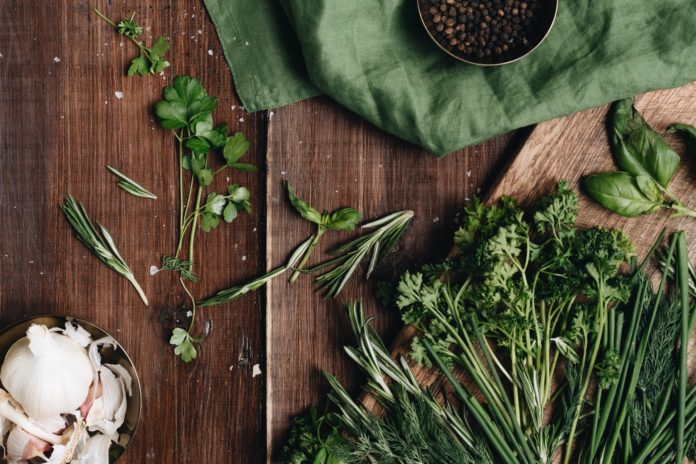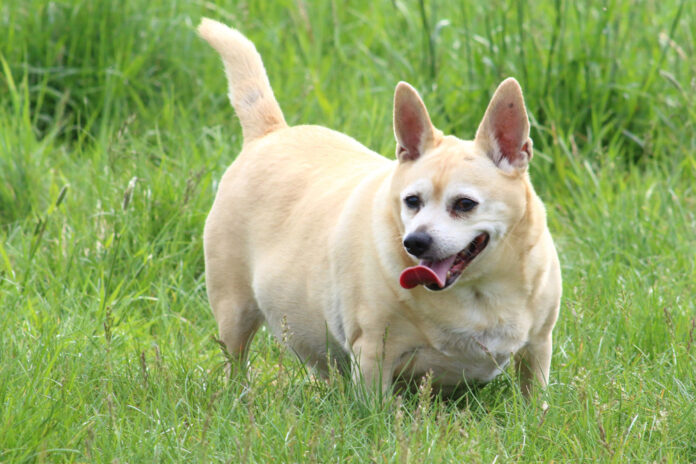11 herbs that are good for dogs – both inside and out

Herbs add a lot to your dog’s well-being, whether they’re included in his diet or used for healing and well-being. These 11 herbs are good for dogs, and can be incorporated into everything from teas and treats to rinses and salves.
Herbs play an important role both in our cuisine and in healing, and we can share those attributes with our dogs too. There is so much you can do with herbs, whether it’s making simple tisanes and teas, including them in your dog’s treats, preparing a simple rinse for his coat, or just snipping some fresh herbs from the garden and adding them to his meals, and your own. Here are 11 herbs you can share with your canine companion along with some easy recipes, from teas to treats to rinses.
1. Basil
Once upon a time, you would have had to travel to Asia, Africa or India to experience the wonderful aroma of the basil plant. Today, there are over 60 varieties of this herb, and they are all a bit different, from traditional sweet basil to the spicy flavors of anise or cinnamon basil. This herb is an excellent source of vitamin K, a very good source of iron, calcium, and vitamin A, and also provides dietary fiber, manganese, magnesium, vitamin C, and potassium. Basil has antibacterial properties, acts as an anti-inflammatory, supports cardiovascular health, and helps protect against free radical damage.
2. Chamomile
The word “chamomile” actually comes from ancient Greece, and means “ground apple.” Chamomile is recognized for its calming effects, but it is also an anti-inflammatory and helps support the healing of gastrointestinal issues like stomach ulcers and inflammatory bowel disease. If your dog experiences itchy, inflamed skin from a bite or sting, try using cool chamomile tea as a soothing rinse. The tea bag itself can be used as a compress too.
3. Dandelion
Dandelion is related to the sunflower family and is a source of vitamins A, C, E, and K, calcium, fiber, folate, iron, magnesium, manganese, phosphorus, potassium, silicon, and zinc. Dandelion leaves contain more vitamin A than carrots, and the root is an excellent source of inulin, which encourages the growth of beneficial bacteria in the intestinal tract. Dandelion greens also support liver function, improve tooth enamel, and act as a blood tonic. Native Americans used the split stems of dandelions to rub on bee stings. Dandelion supports the cardiovascular system and promotes healthy teeth and bones. Dandelion greens are a perfect substitute for spinach and Swiss chard and are a great addition to your dog’s diet plan.
Here’s an old Mennonite recipe for cooking and freezing dandelion greens. Cut the roots from the greens and discard. Wash the greens well in cold water. Bring a pot of water to a rolling boil and put the greens into the water by the handful. Bring the water back to a boil, and cook the greens just until they are wilted, which will take two to three minutes. Drain immediately and run cold water over the greens to stop the cooking process. Squeeze out as much water as possible. You can then wrap the greens and freeze for future use.
4. Dill
Dill seed has antimicrobial properties and helps fight infections. It contains volatile oil constituents that combine to cause an anti-foaming action in the stomach, much like the anti-gas remedies that line pharmacy shelves. This makes dill particularly soothing to the digestive tract. It is also recognized as an antispasmodic and helps reduce flatulence. Dill helps tonify the liver and pancreas, and is great for bad breath, especially when used in combination with parsley and mint. Dill also helps dissolve uric acid in cases of kidney and bladder stones, and may treat chronic constipation. The ground seeds can aid with dispelling intestinal worms. Externally, dill juice can help heal skin irritations and inflammation, including heat rash; and a rinse made with dill, feverfew flowers, and yarrow has been said to discourage fleas. Dill seeds contains calcium, iron, magnesium, phosphorus, potassium, sodium, zinc, thiamine, riboflavin, niacin, vitamin A, a variety of amino acids, and dietary fiber. Dill also contains carvone, anethofuran, and limonene, which have been shown to increase the production of cancer-fighting enzymes, like glutathione S-transferase, known to react with certain types of carcinogenic chemicals and eliminate them from our dog’s system. In fact, dill is referred to as a chemoprotective food.
Store fresh dill in the refrigerator, wrapped in damp paper towel, or simply place it in a small vase with some water or a Mason jar. Dill can also be frozen in ice cube trays. Simply combine fresh dill with filtered water or your choice of broth. Dill seed can also be sprinkled on food, just before serving.
5. Horsetail
Horsetail is a rich source of silicic acid and silicates, which provide elemental silicon. It also contains sterols, campesterol, isofucosterol, alkaloids, flavonoids, saponins, and silicon. Research going back to 1993 reports that horsetail helps with the formation of bone and cartilage.
Horsetail is a primitive plant, going all the way back to the Paleozoic era, millions of years ago. Cultures throughout the world have used it as a remedy for bladder and kidney issues, arthritis, ulcers, and even tuberculosis. It has been used topically to stop bleeding from wounds and promote healing, and to strengthen skin and coat, nails, and hooves. Horsetail has demonstrated anti-inflammatory and analgesic properties in the laboratory setting, and research conducted in 2003 reported that it may even provide protection from radiation.
6. Mint
Mint species, including wild mint, catmint, spearmint, and peppermint, are non-toxic and can be included in your dog’s (and cat’s) diet. In The Complete Herbal Handbook for the Dog and Cat, Juliette de Bairacli Levy recommends using an infusion of all parts of the peppermint plant for loss of appetite. For “doggie breath,” consider finely chopping some fresh mint from the garden, and adding it your dog’s daily diet program. In combination with ginger, mint has long been considered as soothing to the gastrointestinal system. A high quality peppermint essential mint can also be used when making homemade flea spray.
7. Oregano
Often referred to as the “cure in the cupboard,” oregano has been cultivated in France since the Middle Ages, and was introduced to North America in the early 20th century. Oregano contains calcium, fiber, iron, manganese, Omega-3 fatty acids, and vitamins A, C, and K. It also contains thymol and carvacrol, volatile oils that inhibit the growth of bacteria and contain many phytonutrients. Oregano is packed with antioxidants. In fact, it contains more antioxidant power than apples and blueberries. Research demonstrates that beta-caryophyllene, a chemical found in oregano, may inhibit inflammation. Scientists believe this anti-inflammatory effect may have an impact on the treatment of osteoporosis, arteriosclerosis, and Crohn’s disease. Oregano tea soothes an upset stomach and chest congestion, and also helps relieve muscle pain.
Store fresh oregano in the refrigerator, wrapped in a damp towel, or freeze in an airtight container.
8. Parsley
Parsley is one of our most concentrated food sources. Its history goes back more than 2,000 years, when it was first used as a medicinal herb in the Eastern Mediterranean. Parsley is rich in vitamins A, C, and K, iron, folate, a variety of minerals, and also contains a variety of volatile oils, including myristin, which is thought to inhibit tumor formation, especially in the lungs, and histadine, an amino acid also found to inhibit tumor growth. Parsley is referred to as a chemoprotective food because it may help neutralize a variety of carcinogens, including the benzopyrenes found in cigarette smoke.
Keep parsley fresh by sprinkling it with water, wrapping it in paper towel, and refrigerating in a plastic bag; or simply put stems of parsley in a glass of water, like flowers, and refrigerate.
9. Sage
Sage has a long history, going all the way back to ancient Roman times, when it was added to the diet in order to better digest fatty foods. Powdered sage leaves were sprinkled on food, just like pepper. Sage contains vitamins A, E, and K, and a variety of trace minerals, including calcium, magnesium, potassium, phosphorus, and zinc. It has antiseptic, antibacterial, antimicrobial, and astringent properties. Consider adding sage to your dog’s diet to help soothe his gastrointestinal tract. Sage leaves also contain rosmarinic acid, which can help support dogs with seasonal allergies.
10. Thyme
Thyme has a colorful history. The ancient Egyptians used it as an embalming agent, whie in Greece, it was burned in temples as sacred incense. Thyme contains vitamin K, iron, manganese, calcium, and dietary fiber. Thymol, the herb’s primary active ingredient, helps inhibit the growth of fungus and bacteria. Thyme also contains a variety of flavonoids, including luteolin and thymonin, which increase its antioxidant properties.
11. Turmeric
Turmeric is a perennial herb that belongs to the ginger family. Curcurmin is the orange-yellow pigment that gives turmeric its colour. It has a very long history as a spice, and is known for its anti-inflammatory and antioxidant impact. Curcurmin has more antioxidant properties than vitamin E, and its potential as a cancer preventive has been supported by many studies. Turmeric increases bile production and flow, and protects the stomach and liver. It is the perfect herb to sprinkle on your dog’s food. It can also be used to treat minor cuts; simply wash the wound, sprinkle with turmeric, and top with a bandage.
RECIPES
Healthy herbal teas
Medicinal sage tea
Place 1 tablespoon of fresh sage leaves, or 1½ teaspoons of dried sage leaves, in a four-cup Pyrex measuring cup or medium-sized pot. Add 2 teaspoons of honey and the juice from half a lemon. Bruise the sage leaves with the back of wooden spoon. Pour 2½ cups boiling water over the sage, honey, and lemon, and cover measuring cup or pot with a plate. Allow to infuse for half an hour. Then simply strain and cool. This tonic can be stored in the refrigerator. Add it to your dog’s food or drinking water.
Fresh sage tea
Put 1 tablespoon of fresh sage leaves (use the young tips for this brew) in a small jug or large Mason jar and pour 1¼ cups boiling water over it. Cover the jar and infuse for 10 minutes. Strain and use at once, or store in the refrigerator for two or three days.
Raw sage leaves clean teeth and gums and leave a fresh taste in the mouth. Try adding some freshly-strained and cooled sage tea to your dog’s food, or use as a “toothpaste.”
Digestive tea
Combine 4 teaspoons of fresh mint (or 2 teaspoons of dried mint), ¼ teaspoon of dried sage, and 1 slice of fresh ginger in a large mug. Add 1 cup of boiling water, and steep for two minutes. Adding a teaspoon of Manuka “healing” honey will make this simple remedy even better!
Oregano tea
Steep 2 teaspoons of fresh oregano, or 1 teaspoon of dried oregano, in a cup of boiling water for ten minutes.
Dill tea
In a teapot or other small pot, pour ½ cup of boiling filtered water over 1 teaspoon of dry and lightly crushed dill seeds. A mortar and pestle work very well for crushing the seeds. Cover and steep for 10 minutes. Strain the tea, discard the seeds, and let the tea cool before serving. You can add dill tea to your dog’s food or water bowl.
When making treats for your pet, try replacing ¼ cup of liquid in the recipe with the dill tea.
In Herbs for Pets, Mary L. Wulff-Tilford and Gregory L. Tilford recommend that if your dog is belching, try giving him 2 to 8 ounces of cooled dill seed tea.
Parsley tea
Place 4 teaspoons of freshly picked parsley (flat or curly) or 2 teaspoons of dried parsley in a large mug. Cover with 1 cup of boiling water. Allow to steep for 10 to 30 minutes. Cool and serve, adding the brew to your dog’s food or water bowl.
Herb stuffed power pops
Ingredients
1 pound ground elk or other ground meat of your choice
1 cup fresh mint leaves, snipped or torn into pieces
1 cup fresh oregano leaves, snipped or torn into pieces
¼ to ½ teaspoon turmeric
½ teaspoon sea salt
2 tablespoons first pressed/extra virgin olive oil
Instructions
Raw: Make small meatballs with the ground meat. Pinch each meatball and fill the indentation with the fresh herbs. Roll in your hands and place in a bowl. Continue until your bowl is packed with herb-filled “pinch pots” of ground meat. Drizzle with olive oil, and sprinkle with sea salt and turmeric. Store in a bowl in the refrigerator or freezer for future use.
Cooked: Follow the instructions above for making “pinch pots” of ground meat and fresh herbs. Place olive oil in a medium-sized pan. Turn to high, and just as the oil begins to sizzle, turn the heat down to medium and add the meatballs. Sprinkle with turmeric and sea salt. Using a wooden spoon or spatula, move the meat balls around in the olive oil, then turn the heat to simmer and cook until there is no pink left in the meat. Remove pan from heat and place meatballs in a bowl. Allow to cool, then store in the refrigerator; you can also place the meatballs in an airtight container or Ziploc bag and freeze.
Barkers beef
Ingredients
1 pound grass-fed stewing beef, cut in chunks
1 cup mixed fresh herbs, for example, oregano, marjoram, parsley, sage, basil, thyme
½ to 1 teaspoon sea salt
1½ cups tomatoes with juice
Instructions
Place olive oil in a medium-sized pan. Turn to high, and just as the oil begins to sizzle, turn the heat down to medium and add the beef chunks. Using a wooden spoon or spatula, coat the beef chunks in the olive oil. Add the tomatoes and mix thoroughly with the beef. Add fresh herbs and sprinkle with sea salt. Turn heat down to simmer for 20 minutes. Remove pan from heat and allow to cool before serving. Store in the refrigerator or freezer for future use. In our house, some of the humans share this meal, by serving it with noodles or quinoa, and an extra hit of spice!
For external use
Horsetail rinses for your dog’s coat
Recipe 1: If you can’t find wild horsetail, dried horsetail is available in bulk at many health food stores; certified powdered horsetail supplements are also available. Place 4 cups of filtered water in a medium-sized pot, along with one small bottle organic apple cider vinegar (including the “mother”) and 2 cups fresh horsetail, or 1 to 1½ cups dried horsetail. Bring to a boil, then remove the pot from the stove. Cover and allow mixture to steep for 20 to 30 minutes. Cool, then add your choice of 15 drops of chamomile and/or lavender essential oil (remember to use pure, high quality oils). Transfer to a spray bottle. This spray can be used after a “shampoo” or simply sprayed on your dog’s wet or dry coat. The delightful smell of vinegar dissipates as his coat dries; you can also leave the rinse on for 10 to 15 minutes, and then rinse clear.
Recipe 2: Fill a regular-sized Mason jar with ½ to 2/3 cup of dried horsetail. Add apple cider vinegar and fill to the top of the Mason jar. Add 15 drops of chamomile essential oil, and seal the jar. Let the mixture sit for two weeks in a cool, dark cupboard. Gently shake the Mason jar each day. When ready to use, strain the mixture, put it in a spray bottle, and use as above, adding lavender essential oil if you wish.
Simple herbal salve
Here is a really easy recipe for a soothing salve for your dog’s paws and pads. Don’t be concerned if he sneaks in a lick or two, because this salve contains only natural wholesome ingredients.
In a small pot, over low heat, mix 1/3 cup of first pressed/extra virgin olive oil, 1 tablespoon of grated beeswax, 1 teaspoon of coconut oil, and 1 teaspoon of shea butter until the ingredients have just melted. Stir well throughout the process. Add 10 to 15 drops of chamomile essential oil, and for an extra special touch, a few fresh lavender flowers. Pour the mixture into a small, dark or opaque glass container, and allow your salve to cool completely. If you like, add 10 drops of vitamin E oil as a natural antioxidant and preservative.




